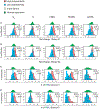Human antibody polyreactivity is governed primarily by the heavy-chain complementarity-determining regions
- PMID: 39392756
- PMCID: PMC11564698
- DOI: 10.1016/j.celrep.2024.114801
Human antibody polyreactivity is governed primarily by the heavy-chain complementarity-determining regions
Abstract
Although antibody variable regions mediate antigen-specific binding, they can also mediate non-specific interactions with non-cognate antigens, impacting diverse immunological processes and the efficacy, safety, and half-life of antibody therapeutics. To understand the molecular basis of antibody non-specificity, we sorted two dissimilar human naïve antibody libraries against multiple reagents to enrich for variants with different levels of polyreactivity. Sequence analysis of >300,000 paired antibody variable regions revealed that the heavy chain primarily mediates human antibody polyreactivity, and this is due to the high positive charge, high hydrophobicity, and combinations thereof in the corresponding complementarity-determining regions, which can be predicted using a machine learning model developed in this work. Notably, a subset of the most important features governing antibody non-specific interactions, namely those that contain tyrosine, also govern specific antigen recognition. Our findings are broadly relevant for understanding fundamental aspects of antibody molecular recognition and the applied aspects of antibody-drug design.
Keywords: CP: Immunology; antibody engineering; deep sequencing; developability; machine learning; non-specific binding; nonspecificity; off-target binding; pharmacokinetic; polyspecificity; repertoire.
Copyright © 2024 The Author(s). Published by Elsevier Inc. All rights reserved.
Conflict of interest statement
Declaration of interests N.R., G.L., M.S.M., and S.K. are current or former employees of the company (Boehringer Ingelheim) that funded this research. P.M.T. is a member of the scientific advisory boards for Nabla Bio, Aureka Biotechnologies, and Dualitas Therapeutics.
Figures






References
Publication types
MeSH terms
Substances
Grants and funding
LinkOut - more resources
Full Text Sources
Miscellaneous

